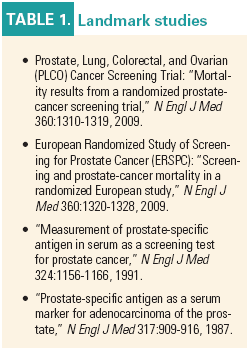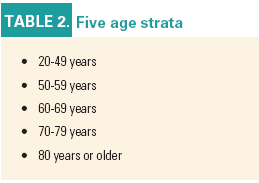Introduction of PSA testing leads to dramatic rise in cancer incidence
More than a million additional cases of prostate cancer have been diagnosed and treated for prostate cancer over the last 20 years because of PSA screening, especially in younger men, according to the results of a SEER database analysis. The authors of this latest strike against screening claimed that most of this excess incidence represents overdiagnosis.
ABSTRACT: Estimating trade-off between mortality benefit and overdiagnosis is problematic when actual benefit is uncertain, study authors say.

More than a million additional cases of prostate cancer have been diagnosed and treated for prostate cancer over the last 20 years because of PSA screening, especially in younger men, according to the results of a SEER database analysis. The authors of this latest strike against screening claimed that most of this excess incidence represents overdiagnosis.
H. Gilbert Welch, MD, MPH, and Peter C. Albertsen, MD, undertook a systematic effort to estimate the number of additional men diagnosed and treated for the disease in the U.S. since the introduction of PSA testing. They chose 1986 as the base year, which was right before the publication of the seminal article on PSA as a serum marker for prostate cancer (see Table 1).
Dr. Welch is from the Department of Veterans Affairs Medical Center in White River Junction, Vt., and the Dartmouth Institute for Health Policy and Clinical Practice at the Dartmouth Medical School in Hanover, N.H. Dr. Albertsen is from the University of Connecticut School of Medicine in Farmington.


They analyzed age-specific incidence trends during the past 20 years and also calculated 95-year-specific and age-specific excess incidence rates (see Table 2).
Overall prostate cancer incidence rose rapidly after 1986 at about 12% per year, peaking in 1992, they found. During the years 1986 to 2005, prostate cancer incidence rose 26% from 119 to 150.5 per 100,000 men. For men ages 60-69 years, the incidence doubled from 349.4 to 666.9 per 100,000 men. For men ages 50-59 years, incidence tripled from 58.4 to 212.7 per 100,000. Finally, for men younger than 50 years, the incidence jumped sevenfold from 1.4 to 9.4 per 100,000 (J Natl Cancer Inst online, August 31, 2009).
Of the 1.3 million men who were diagnosed since 1986, a little over a million were definitively treated for the disease. The age-specific treatment patterns over time did not change, with the exception of less surgery and more radiation therapy, the authors said.
Dr. Welch and Dr. Albertsen acknowledged some of the limitations of their analysis, including the choice of 1986 as a base year because the first clinical trial results did not appear until 1991. Also, the decline in mortality from prostate cancer must be attributed to advances in treatment as well as early diagnosis.

As for their methodology, “our approximation of about one death averted to 20 men overdiagnosed was simply intended to provide an upper-bound estimate,” they said. “A more plausible estimate would assume the mortality benefit observed in the European trial and its earlier reported estimate that 48% of patients diagnosed in the screened group have been overdiagnosed.”
Regardless of the estimates used, all overdiagnosed patients are needlessly exposed to treatment, they argued. “Overdiagnosed patients cannot benefit from treatment because their disease is not destined to progress to cause symptoms or death....it is important that we begin to explicitly communicate to men...the relative magnitude of number of deaths averted to the number of overdiagnosed,” they said.
Prolaris in Practice: Guiding ADT Benefits, Clinical Application, and Expert Insights From ACRO 2025
April 15th 2025Steven E. Finkelstein, MD, DABR, FACRO discuses how Prolaris distinguishes itself from other genomic biomarker platforms by providing uniquely actionable clinical information that quantifies the absolute benefit of androgen deprivation therapy when added to radiation therapy, offering clinicians a more precise tool for personalizing prostate cancer treatment strategies.